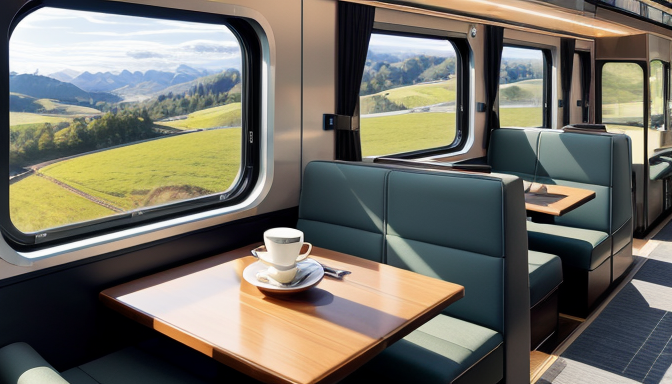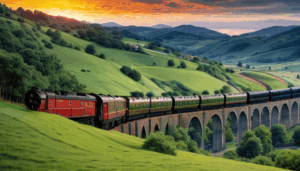In recent years, there’s been a noticeable shift in how people choose to travel. With the hustle and bustle of modern life, many are rediscovering the charm of train journeys. But why is this mode of transport experiencing a renaissance? It’s not just about nostalgia; it’s about the experience, comfort, and the environmental impact that trains offer. Imagine gliding through picturesque landscapes, sipping on a cup of coffee, and enjoying the journey just as much as the destination. Sounds appealing, right?
One major factor driving this comeback is the growing awareness of our planet’s health. Train travel is often heralded as a greener alternative to flying, with trains emitting significantly less carbon dioxide per passenger mile. In fact, studies show that trains can be up to three times more efficient than planes! As travelers become more eco-conscious, they are increasingly opting for trains to minimize their carbon footprints.
Moreover, modern trains are not the rickety carriages of the past. Today, they boast luxurious amenities that cater to the needs of the contemporary traveler. Picture plush seating, onboard dining, and even Wi-Fi. These enhancements make train travel not just a means to an end, but a comfortable experience in itself. With the added convenience of city-center stations, getting to and from the train is a breeze compared to the hassle of airports.
So, whether you’re a seasoned traveler or someone looking to explore new horizons, the resurgence of train journeys is an exciting trend worth considering. They offer a unique blend of comfort, environmental consciousness, and scenic beauty, making every journey an adventure in its own right. After all, isn’t the journey just as important as the destination?
The Environmental Benefits of Train Travel
Train travel is making waves in the travel industry, and for good reason! With growing concerns about climate change and the need for sustainable transportation, trains are emerging as a greener alternative to air travel. Did you know that trains can produce up to 75% less carbon dioxide per passenger compared to planes? That’s a huge difference, especially when you consider the number of travelers flying every day!
One of the most significant environmental advantages of train journeys is their energy efficiency. Trains are designed to carry large numbers of passengers at once, which means that the energy consumed per person is drastically lower. For instance, while a plane might need to burn massive amounts of fuel to stay airborne, trains glide along tracks with minimal resistance, using electricity or diesel more efficiently. This efficiency translates to fewer greenhouse gas emissions, making trains a champion in the fight against global warming.
Moreover, many countries are investing in electrification of train lines, which further reduces their carbon footprint. Electric trains can be powered by renewable energy sources like wind or solar, making them a truly sustainable option. Imagine hopping on a train powered by the sun, all while enjoying the beautiful scenery outside your window!
In addition to reducing emissions, trains help to alleviate road congestion. By providing an alternative to car travel, trains can help decrease the number of vehicles on the road, leading to less air pollution and a decrease in traffic-related accidents. It’s a win-win situation! So, the next time you’re planning a trip, consider the environmental benefits of choosing a train over a plane or a car. Your planet will thank you!

Comfort and Convenience of Modern Trains
When you think of train travel, what comes to mind? Perhaps a cozy seat, a gentle rocking motion, and the rhythmic sound of wheels on tracks. Modern trains have transformed this experience into something truly remarkable. Gone are the days of cramped spaces and outdated facilities; today’s trains are designed with comfort and convenience in mind. Imagine settling into a plush seat with ample legroom, where you can stretch out and relax as you glide through stunning landscapes.
One of the most appealing aspects of train travel is the array of amenities available. Many trains now offer:
- Wi-Fi connectivity to keep you connected on the go
- Power outlets at every seat for charging devices
- Onboard dining options that rival some restaurants
- Spacious restrooms that are frequently maintained
Furthermore, the layout of modern trains often includes quiet cars and family compartments, catering to diverse passenger needs. Whether you’re traveling solo for business or with your family on a vacation, there’s a perfect spot for you. And let’s not forget about the panoramic windows that allow you to soak in the views as you travel. It’s like having a front-row seat to nature’s best show!
In addition to physical comfort, traveling by train also brings a sense of freedom. Unlike air travel, where you’re confined to strict schedules and security lines, trains often allow for a more flexible experience. You can arrive at the station just minutes before departure, and there’s no need to worry about baggage fees or tight connections. Isn’t it refreshing to travel without the usual stress?
So, if you’re looking for a travel option that combines luxury, convenience, and a touch of adventure, consider hopping on a train. The journey itself can be just as exciting as the destination!
Scenic Routes: A Journey Through Landscapes
When it comes to travel, nothing quite compares to the beauty of a train journey winding through breathtaking landscapes. Imagine sitting back, sipping your favorite drink, and watching the world unfold outside your window. Train travel offers a unique perspective, one that allows you to see the changing scenery in real-time, from rolling hills to majestic mountains. It’s like being in a moving painting, where every turn reveals a new masterpiece.
One of the most captivating aspects of train journeys is the variety of scenic routes available around the globe. For instance, the Glacier Express in Switzerland takes you through the stunning Swiss Alps, showcasing snow-capped peaks and charming villages. Meanwhile, the Blue Train in South Africa offers a luxurious ride through the picturesque landscapes of the country, from lush vineyards to arid deserts. These journeys aren’t just about getting from point A to point B; they’re about experiencing the journey itself.
Here are a few other notable scenic train routes that you might want to consider:
- Rocky Mountaineer – Canada: Traverse the awe-inspiring Canadian Rockies.
- Orient Express – Europe: A historic journey through stunning European cities.
- Trans-Siberian Railway – Russia: The ultimate adventure across the vast expanse of Russia.
What makes these train journeys even more special is the chance to connect with fellow travelers and locals. You might find yourself sharing stories with someone from halfway across the world while gazing at the same breathtaking view. It’s this sense of community, combined with the stunning landscapes, that makes train travel an experience unlike any other.
So, the next time you’re planning a getaway, consider hopping on a train. Embrace the journey, soak in the scenery, and create memories that will last a lifetime. After all, life is not just about the destination; it’s about enjoying the ride.

Cost-Effectiveness of Train Travel
When it comes to traveling, one of the first questions that pop into our minds is, “How much is this going to cost me?” Well, let me tell you, train travel is often the hidden gem of cost-effective transportation. With fluctuating fuel prices and unpredictable airfare, hopping on a train can save you a pretty penny while still providing a memorable journey.
Consider this: train tickets can be significantly cheaper than plane tickets, especially if you book in advance. Plus, there are no hidden fees that airlines often sneak in, like baggage charges or seat selection fees. When you choose to travel by train, you pay for your ticket and that’s it! You can even bring your own snacks, which is not only a money-saver but also a way to enjoy your favorite treats while you travel.
To give you a clearer picture, let’s compare the costs:
| Travel Method | Average Cost | Additional Fees |
|---|---|---|
| Train | $100 (for a long-distance trip) | No additional fees |
| Plane | $150 – $300 (depending on the route) | Baggage fees, seat selection fees |
Moreover, let’s not forget about the convenience factor. Many train stations are located right in the heart of cities, which means you save on transportation costs to and from the airport. You can simply hop off the train and dive straight into your adventure!
In summary, with lower ticket prices, no hidden fees, and the added bonus of convenience, train travel is not just a comfortable option, but also a smart financial choice. So, next time you’re planning a trip, why not consider the train? Your wallet will thank you!
Cultural and Historical Significance of Railways
Railways are not just about getting from point A to point B; they are a symbol of progress and a vital part of our shared history. Since their inception in the early 19th century, trains have transformed the way we connect, trade, and travel. Can you imagine a world without railways? It would be like a book without pages—lacking depth and richness!
From the iconic steam engines that powered the Industrial Revolution to the sleek bullet trains of today, railways have played a crucial role in shaping economies and societies. They have facilitated migration, enabling people to explore new opportunities and cultures. This movement of people has not only enriched local communities but has also fostered a sense of global interconnectedness.
Furthermore, railways have often been at the heart of significant cultural moments. Think about the Great Western Railway in the UK or the Trans-Siberian Railway in Russia; these routes are steeped in stories and experiences that reflect the spirit of their times. They have inspired countless works of art, literature, and music, becoming a canvas for human emotion and creativity.
To better understand their impact, let’s look at a few key points:
- Economic Growth: Railways have been a backbone for industries, allowing for the swift transport of goods.
- Cultural Exchange: They have enabled diverse cultures to interact, leading to a rich tapestry of traditions and practices.
- Historical Events: Many pivotal moments in history have been influenced by the development of railways, from wars to migrations.
In conclusion, the cultural and historical significance of railways is profound. They are not merely transportation systems; they are arteries of civilization, connecting stories, people, and places across time and space. So, the next time you board a train, take a moment to appreciate the legacy of those iron tracks beneath you!
Frequently Asked Questions
- Why should I choose train travel over flying?
Train travel offers a more relaxed experience, with less hassle compared to airports. You can enjoy scenic views, stretch your legs, and often avoid long security lines!
- Are trains really more environmentally friendly?
Absolutely! Trains emit significantly lower carbon emissions per passenger compared to planes, making them a greener choice for the eco-conscious traveler.
- What amenities can I expect on modern trains?
Modern trains come equipped with comfortable seating, dining options, Wi-Fi, and sometimes even sleeper cabins for overnight journeys, ensuring a cozy travel experience.
- How do ticket prices compare to flights?
Train tickets can often be more economical, especially when considering hidden fees of air travel. Plus, prices can be more stable, helping you budget better!
- Which are some of the most scenic train routes?
Some breathtaking routes include the Glacier Express in Switzerland and the Rocky Mountaineer in Canada, both offering stunning views that you simply can’t get from a plane!
- What historical significance do railways hold?
Railways have been pivotal in shaping economies and cultures, connecting distant regions and fostering trade, which is why they hold a special place in history.

